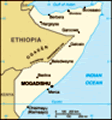Somali Government, Somalia Government
Advertisement
Country name: Conventional long form: none conventional short form: Somalia former: Somali Republic, Somali Democratic Republic
Government type: No permanent national government; transitional, parliamentary federal government
Capital: Mogadishu
Administrative divisions: 18 regions (plural - NA, singular - gobolka); Awdal, Bakool, Banaadir, Bari, Bay, Galguduud, Gedo, Hiiraan, Jubbada Dhexe, Jubbada Hoose, Mudug, Nugaal, Sanaag, Shabeellaha Dhexe, Shabeellaha Hoose, Sool, Togdheer, Woqooyi Galbeed
Independence: 1 July 1960 (from a merger of British Somaliland, which became independent from the UK on 26 June 1960, and Italian Somaliland, which became independent from the Italian-administered UN trusteeship on 1 July 1960, to form the Somali Republic)
National holiday: Foundation of the Somali Republic, 1 July (1960); note - 26 June (1960) in Somaliland
Constitution: 25 August 1979, presidential approval 23 September 1979 note: the formation of transitional governing institutions, known as the Transitional Federal Government, is currently ongoing
Legal system: No national system; Shari'a and secular courts are in some localities
Suffrage: 18 years of age; universal
Executive branch: Chief of state: Abdullahi YUSUF Ahmed (since 14 October 2004); note - a new Transitional Federal Government consisting of a 275-member parliament was established in October 2004 but remains resident in Nairobi, Kenya, and has not extablished effective governance inside Somalia head of government: Prime Minister Ali Muhammad GHEDI (since 24 December 2004) cabinet: Cabinet appointed by the prime minister and approved by the Transitional Federal Assembly election results: Abdullahi YUSUF Ahmed, the leader of the Puntland region of Somalia, was elected president by the Transitional Federal Assembly
Legislative branch: Unicameral National Assembly note: fledgling parliament; a 275-member Transitional Federal Assembly; the new parliament consists of 61 seats assigned to each of four large clan groups (Darod, Digil-Mirifle, Dir, and Hawiye) with the remaining 31 seats divided between minority clans
Judicial branch: Following the breakdown of the central government, most regions have reverted to local forms of conflict resolution, either secular, traditional clan-based arbitration, or Islamic (Shari'a) law with a provision for appeal of all sentences
Political parties and leaders: None
Political pressure groups and leaders: Numerous clan and subclan factions are currently vying for power
International organization participation: ACP, AfDB, AFESD, AMF, AU, CAEU, FAO, G-77, IBRD, ICAO, ICRM, IDA, IDB, IFAD, IFC, IFRCS, IGAD, ILO, IMF, IMO, Interpol, IOC, IOM (observer), ITU, LAS, NAM, OIC, UN, UNCTAD, UNESCO, UNHCR, UNIDO, UPU, WFTU, WHO, WIPO, WMO
Diplomatic representation in the US: Somalia does not have an embassy in the US (ceased operations on 8 May 1991); note - the TNG and other factions have representatives in Washington and at the United Nations
Diplomatic representation from the US: The US does not have an embassy in Somalia; US interests are represented by the US Embassy in Nairobi, Kenya at United Nations Avenue, Gigira, Nairobi; mailing address: Unit 64100, Nairobi; APO AE 09831; telephone: [254] (20) 363-6000; FAX [254] (20) 363-6157
Flag description: Light blue with a large white five-pointed star in the center; blue field influenced by the flag of the UN
Advertisement
The information here has been derived from Public Domain Sources such as the CIA World Factbook. No liability can be taken for any inaccuracies.
Tot: 0.043s; Tpl: 0.007s; cc: 5; qc: 10; dbt: 0.017s; 1; m:domysql w:travelblog (10.17.0.13); sld: 1;
; mem: 1.1mb

 The regime of Mohamed SIAD Barre was ousted in January 1991; turmoil, factional fighting, and anarchy have followed in the years since. In May of 1991, northern clans declared an independent Republic of Somaliland that now includes the administrative...
The regime of Mohamed SIAD Barre was ousted in January 1991; turmoil, factional fighting, and anarchy have followed in the years since. In May of 1991, northern clans declared an independent Republic of Somaliland that now includes the administrative...
